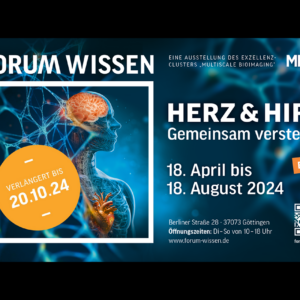16.10.2024
Ex vivo imaging reveals the spatiotemporal control of ovulation
Authors Thomas C, Marx TL, Penir SM, Schuh M Journal Nature Cell Biology Citation Nat Cell Biol. 2024 Oct 16. Abstract During ovulation, an egg is released from an ovarian follicle, ready for fertilization. Ovulation occurs inside the body, impeding direct studies of its progression. Therefore, the exact mechanisms that
10.10.2024
Intra-molecular distances in biomolecules measured optically with Ångström precision
A team led by physicists Steffen Sahl and Stefan Hell at the Max Planck Institute (MPI) for Multidisciplinary Sciences in Göttingen and the MPI for Medical Research in Heidelberg has succeeded in measuring distances within biomolecules using a light microscope, down to 1 nanometer and with Ångström precision. The intra-molecular
10.10.2024
Intra-molecular distances in biomolecules measured optically with Ångström precision
A team led by physicists Steffen Sahl and Stefan Hell at the Max Planck Institute (MPI) for Multidisciplinary Sciences in Göttingen and the MPI for Medical Research in Heidelberg has succeeded in measuring distances within biomolecules using a light microscope, down to 1 nanometer and with Ångström precision. The intra-molecular
10.10.2024
Direct optical measuerement of intramolecular distances with angstrom precision
Authors Sahl SJ, Matthias J, Inamdar K, Weber M, Khan TA, Brüser C, Jakobs S, Becker S, Griesinger C, Broichhagen J, Hell SW Journal Science Citation Science. 2024 Oct 11;386(6718):180-187. Abstract Optical investigations of nanometer distances between proteins, their subunits, or other biomolecules have been the exclusive prerogative of Förster
10.10.2024
NanoPlex: a universal strategy for fluorescence microscopy multiplexing using nanobodies with erasable signals
Authors Mougios N, Cotroneo ER, Imse N, Setzke J, Rizzoli S, Simeth NA, Tsukanov R, Opazo F Journal Nature Communications Citation Nat Commun. 2024 Oct 10;15(1):8771. Abstract Fluorescence microscopy has long been a transformative technique in biological sciences. Nevertheless, most implementations are limited to a few targets, which have been
09.10.2024
ONE microscopy: from molecule to 3D structure with conventional microscopy
Researchers at the University Medical Center Göttingen (UMG) have developed a new method that makes it possible for the first time to image the three-dimensional shape of proteins with a conventional microscope. Combined with artificial intelligence, One-step Nanoscale Expansion (ONE) microscopy enables the detection of structural changes in damaged or
09.10.2024
ONE microscopy: from molecule to 3D structure with conventional microscopy
Researchers at the University Medical Center Göttingen (UMG) have developed a new method that makes it possible for the first time to image the three-dimensional shape of proteins with a conventional microscope. Combined with artificial intelligence, One-step Nanoscale Expansion (ONE) microscopy enables the detection of structural changes in damaged or
09.10.2024
One-step nanoscale expansion microscopy reveals individual protein shapes
Authors Shaib AH, Chouaib AA, Chowdhury R, Altendorf J, Mihaylov D, Zhang C, Krah D, Imani V, Spencer RKW, Georgiev SV, Mougios N, Monga M, Reshetniak S, Mimoso T, Chen H, Fatehbasharzad P, Crzan D, Saal KA, Alawieh MM, Alawar N, Eilts J, Kang J, Soleimani A, Müller M, Pape
08.10.2024
“Heart & Brain – understanding together” – Our exhibition has been extended!
Exhibition at the Forum Wissen Göttingen extended until Oct 20, 2024 Due to the enormous demand – more than 17.000 people have seen the exhibition so far – it will be extended until 20 October 2024. How does a “patch” for the heart work? Can we hear with





